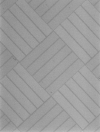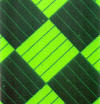|
|
|
|
Single-layer Optical Devices An analog of the standard SFIL process flow was used to create a micropolarizer array. This process scheme was described in Colburn (SPIE 2000), and utilized a roller press in place of the traditional imprint apparatus. A sheet of polycarbonate with an array of orthogonal 100 nm lines/spaces was coated with a thin fluorocarbon film, and was used as the imprint template. Following imprinting and etch transfer, Ti was deposited at a rate of 2.5 nm/s in a metal evaporator. The substrate was immersed in an acetone bath and subjected to ultrasonication to remove the resist features, leaving the Ti that was adhered to the substrate. The result of this lift-off process was an alternating array of orthogonal metal gratings that comprised the micropolarizers shown in Figure 1. Figure 1a is an optical micrograph of the image illuminated through the backside with non-polarized light, and Figure 1b shows the array illuminated with polarized light. The visible thin lines in the square regions shown in Figure 1b are perpendicular to the direction of the Ti grating in that region, and serve to support the lines. It was thought that 100 nm resist lines at the aspect ratios used for the metal lift-off process might collapse if designed to extend the entire width of the 100 micron square. The polarization ratio for the device was measured to be between 5:1 and 10:1, but could be improved by redesign of these support struts.
Figure 1. Micropolarizer array formed using an analog of SFIL coupled with a Ti lift-off process. a) Array of micropolarizers illuminated with non-polarized light, and b) illuminated with polarized light. | |
|
|
|



